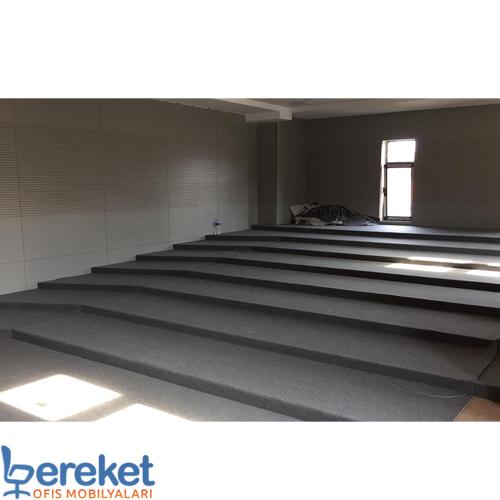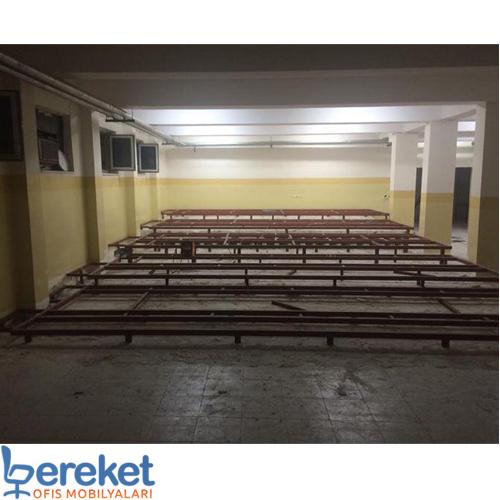



How Raised Flooring Is Done: Comprehensive Guide and Benefits
Raised flooring is a system used in modern buildings to address technological and aesthetic needs. This article explains what raised flooring is, how it is implemented, why it is important, and where it is used in a clear and simple manner. Topics such as how raised flooring is done, the importance of raised flooring, raised flooring prices, school raised flooring costs, and the benefits of raised flooring are covered in detail.
What is Raised Flooring?
Raised flooring involves adding a secondary floor layer above the existing concrete floor. This layer consists of panels supported by adjustable feet, creating a space underneath. This space is used to neatly store infrastructure components such as electrical cables, data cables, or ventilation systems. This results in a more organized and aesthetically pleasing environment. For instance, in an office, cables are hidden under the floor instead of being visible.
The system is typically applied at heights ranging from 10 centimeters to 1 meter. Panels are made from durable materials like calcium sulfate, chipboard, or lightweight concrete, while feet can be steel, aluminum, or plastic. Coatings such as PVC, laminate, or carpet tiles are added to make the floor both functional and attractive.
Importance of Raised Flooring
The importance of raised flooring lies in its ability to enhance spaces both functionally and visually. Modern buildings, particularly those with heavy technological use, have numerous cables and infrastructure components. Exposed cables pose safety risks and look unappealing. Raised flooring hides these components under the floor, ensuring a safe and organized environment. Its modular design also allows for easy modifications when needed.
In schools, keeping cables out of reach is critical for student safety. In conference rooms, raised flooring improves acoustic performance and hides technical equipment, creating a more professional setting. This system offers a practical and durable solution.
Benefits of Raised Flooring
The benefits of raised flooring make it a preferred choice in various settings. Key benefits include:
- Organized Infrastructure: Electrical, data, and ventilation systems are neatly stored under the floor, maintaining a clean appearance.
- Flexibility: Modular panels make it easy to add new infrastructure or modify existing setups.
- Aesthetics: Coatings like PVC, laminate, or carpet tiles give spaces a modern and professional look.
- Safety: Fire-resistant or antistatic panels provide safety, especially in schools and tech-heavy areas.
- Easy Maintenance: Removable panels allow quick access to infrastructure for maintenance.
These benefits make raised flooring ideal for offices, schools, and conference rooms.
How Raised Flooring Is Done?
How raised flooring is done is a key question for those wanting to understand the process. The implementation involves the following steps:
- Survey and Planning: The area is assessed to determine its size, required floor height, and coating type.
- Floor Preparation: The concrete floor is cleaned to create a smooth surface. Existing coatings, such as tiles, may be removed if necessary.
- Installing Feet: Adjustable feet are placed to raise the floor to the desired height, typically made from durable materials like steel or aluminum.
- Panel Installation: Panels made of calcium sulfate, chipboard, or lightweight concrete are placed on the feet and finished with coatings like carpet tiles, PVC, or laminate.
- Infrastructure Setup: Electrical cables, data cables, or ventilation systems are organized in the space under the floor.
- Final Inspection: The floor is checked for strength and appearance before the project is completed.
This process is quick and practical due to its modular design, simplifying maintenance and future changes.
School Raised Flooring Costs and Applications
School raised flooring costs vary depending on project specifics, but the system is highly beneficial in schools. It is commonly used in computer labs, libraries, or multi-purpose halls. In computer labs, it ensures cables are organized and safe. Antistatic coatings prevent damage to devices from electrostatic discharge. Sound-insulating coatings reduce noise in classrooms, creating a better learning environment. The modular design facilitates renovations or changes in school buildings.
Raised Flooring Prices and Influencing Factors
Raised Flooring Prices vary based on the project’s scope and materials used. Key influencing factors include:
- Material Type: The choice of panels (calcium sulfate, chipboard, or lightweight concrete) and coatings (PVC, laminate, or carpet tiles) is significant.
- Floor Height: Higher floors require more materials for adjustable feet.
- Area Size: Larger areas demand more panels and feet.
- Special Features: Features like fire resistance, antistatic properties, or sound insulation affect the project’s scope.
These factors are carefully evaluated during planning to select appropriate solutions.
Raised Flooring Models and Features
Raised flooring systems offer various models tailored to different needs. Calcium sulfate panels are fire-resistant, ideal for tech rooms. Chipboard panels are lighter and more cost-effective. Lightweight concrete panels support heavy loads, suitable for large spaces. Coating options include antistatic PVC for computer labs or acoustic carpet tiles for conference rooms. These features meet both functional and aesthetic requirements. The modular design enhances the benefits of raised flooring by simplifying maintenance and updates. Understanding how raised flooring is done highlights the system’s efficiency and practicality. For those considering school raised flooring costs, it provides a long-term, effective solution.
How Raised Flooring Is Done: Comprehensive Guide and Benefits
Raised flooring is a system used in modern buildings to address technological and aesthetic needs. This article explains what raised flooring is, how it is implemented, why it is important, and where it is used in a clear and simple manner. Topics such as how raised flooring is done, the importance of raised flooring, raised flooring prices, school raised flooring costs, and the benefits of raised flooring are covered in detail.
What is Raised Flooring?
Raised flooring involves adding a secondary floor layer above the existing concrete floor. This layer consists of panels supported by adjustable feet, creating a space underneath. This space is used to neatly store infrastructure components such as electrical cables, data cables, or ventilation systems. This results in a more organized and aesthetically pleasing environment. For instance, in an office, cables are hidden under the floor instead of being visible.
The system is typically applied at heights ranging from 10 centimeters to 1 meter. Panels are made from durable materials like calcium sulfate, chipboard, or lightweight concrete, while feet can be steel, aluminum, or plastic. Coatings such as PVC, laminate, or carpet tiles are added to make the floor both functional and attractive.
Importance of Raised Flooring
The importance of raised flooring lies in its ability to enhance spaces both functionally and visually. Modern buildings, particularly those with heavy technological use, have numerous cables and infrastructure components. Exposed cables pose safety risks and look unappealing. Raised flooring hides these components under the floor, ensuring a safe and organized environment. Its modular design also allows for easy modifications when needed.
In schools, keeping cables out of reach is critical for student safety. In conference rooms, raised flooring improves acoustic performance and hides technical equipment, creating a more professional setting. This system offers a practical and durable solution.
Benefits of Raised Flooring
The benefits of raised flooring make it a preferred choice in various settings. Key benefits include:
- Organized Infrastructure: Electrical, data, and ventilation systems are neatly stored under the floor, maintaining a clean appearance.
- Flexibility: Modular panels make it easy to add new infrastructure or modify existing setups.
- Aesthetics: Coatings like PVC, laminate, or carpet tiles give spaces a modern and professional look.
- Safety: Fire-resistant or antistatic panels provide safety, especially in schools and tech-heavy areas.
- Easy Maintenance: Removable panels allow quick access to infrastructure for maintenance.
These benefits make raised flooring ideal for offices, schools, and conference rooms.
How Raised Flooring Is Done?
How raised flooring is done is a key question for those wanting to understand the process. The implementation involves the following steps:
- Survey and Planning: The area is assessed to determine its size, required floor height, and coating type.
- Floor Preparation: The concrete floor is cleaned to create a smooth surface. Existing coatings, such as tiles, may be removed if necessary.
- Installing Feet: Adjustable feet are placed to raise the floor to the desired height, typically made from durable materials like steel or aluminum.
- Panel Installation: Panels made of calcium sulfate, chipboard, or lightweight concrete are placed on the feet and finished with coatings like carpet tiles, PVC, or laminate.
- Infrastructure Setup: Electrical cables, data cables, or ventilation systems are organized in the space under the floor.
- Final Inspection: The floor is checked for strength and appearance before the project is completed.
This process is quick and practical due to its modular design, simplifying maintenance and future changes.
School Raised Flooring Costs and Applications
School raised flooring costs vary depending on project specifics, but the system is highly beneficial in schools. It is commonly used in computer labs, libraries, or multi-purpose halls. In computer labs, it ensures cables are organized and safe. Antistatic coatings prevent damage to devices from electrostatic discharge. Sound-insulating coatings reduce noise in classrooms, creating a better learning environment. The modular design facilitates renovations or changes in school buildings.
Raised Flooring Prices and Influencing Factors
Raised Flooring Prices vary based on the project’s scope and materials used. Key influencing factors include:
- Material Type: The choice of panels (calcium sulfate, chipboard, or lightweight concrete) and coatings (PVC, laminate, or carpet tiles) is significant.
- Floor Height: Higher floors require more materials for adjustable feet.
- Area Size: Larger areas demand more panels and feet.
- Special Features: Features like fire resistance, antistatic properties, or sound insulation affect the project’s scope.
These factors are carefully evaluated during planning to select appropriate solutions.
Raised Flooring Models and Features
Raised flooring systems offer various models tailored to different needs. Calcium sulfate panels are fire-resistant, ideal for tech rooms. Chipboard panels are lighter and more cost-effective. Lightweight concrete panels support heavy loads, suitable for large spaces. Coating options include antistatic PVC for computer labs or acoustic carpet tiles for conference rooms. These features meet both functional and aesthetic requirements. The modular design enhances the benefits of raised flooring by simplifying maintenance and updates. Understanding how raised flooring is done highlights the system’s efficiency and practicality. For those considering school raised flooring costs, it provides a long-term, effective solution.
- Stock: In Stock
- Model: Zemin Yükseltme Nasıl Yapılır
- SKU CODE: KONF 1538





